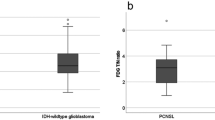Abstract
True multicentric glioblastoma multiforme (GBM) is rare and consists of separate distinct tumors in different cerebral lobes or hemispheres without any apparent route of dissemination. Few data are available describing its imaging using positron emission tomography (PET) with [18F]-fluoro-2-deoxy-d-glucose (FDG). In this paper, we report on the case of a man with bifocal tumor in the right frontal and temporal lobes who underwent FDG-PET imaging. Visual and semiquantitative analysis showed two different metabolic patterns with much more intense uptake in the smaller temporal lesion. Subtotal surgical removal of the main frontal lesion allowed satisfactory control in the operative site, whereas the temporal lesion was rapidly progressive with occurrence of necrosis, which led to a second neurosurgery. The diagnosis of glioblastoma was confirmed by neuropathological examination in both cases but with much higher immunohistochemical expression of O6-methylguanine-DNA-methyltransferase (MGMT) in the temporal lesion. This report illustrates the potential interest of FDG-PET in multicentric GBMs to identify different metabolic patterns, in accordance with clinical, morphological, and molecular aggressiveness.


Similar content being viewed by others
References
Batzdorf U, Malumid N (1963) The problem of multicentric gliomas. J Neurosurg 20:122–136
Graham DI, Lantos PL (2002) Greenfield’s neuropathology, 7th edn. Arnold, London
Salvati M, Caroli E, Orlando ER, Frati A, Artizzu S, Ferrante L (2003) Multicentric glioma: our experience in 25 patients and critical review of the literature. Neurosurg Rev 26:275–279
Jawahar A, Weilbaecher C, Shorter C et al (2003) Multicentric glioblastoma multiforme determined by positron emission tomography: a case report. Clin Neurol Neurosurg 106:38–40
Sato K, Kameyama M, Ishiwata K et al (1994) Multicentric glioma studied with positron emission tomography. Surg Neurol 42:14–18
Schifter T, Hoffman JM, Hanson MW et al (1993) Serial FDG-PET studies in the prediction of survival in patients with primary brain tumours. J Comput Assist Tomogr 17:509–561
Louis DN, Ohgaki H, Wiestler OD et al (2007) The 2007 WHO classification of tumours of the central nervous system. Acta Neuropathol 114:97–109
Ouafik L, Sauze S, Boudouresque F et al (2002) Neutralization of adrenomedullin inhibits the growth of human glioblastoma cell lines in vitro and suppresses tumor xenograft growth in vivo. Am J Pathol 160:1279–1292
Stupp R, Mason WP, Van den Bent MJ et al (2005) Radiotherapy plus concomitant and adjuvant temozolomide for glioblastoma. N Engl J Med 352:987–996
Esteller M, Garcia-Foncillas J, Andion E et al (2000) Inactivation of the DNA-repair gene MGMT and the clinical response of gliomas to alkylating agents. N Engl J Med 343:1350–1354
Pegg AE, Dolan ME, Moscghel RC (1995) Structure, function, and inhibition of O6-alkylguanine-DNA alkyltransferase. Prog Nucleic Acid Res Mol Biol 51:167–223
Hegi ME, Diserens AC, Gorlia T et al (2005) MGMT gene silencing and benefit from temozolomide in glioblastoma. N Engl J Med 352:997–1003
Sharma MK, Mansur DB, Reifenberger G et al (2007) Distinct genetic signatures among pilocytic astrocytomas relate to their brain region origin. Cancer Res 67:890–900
Taylor MD, Poppleton H, Fuller C et al (2005) Radial glia cells are candidate stem cells of ependymoma. Cancer Cell 8:323–335
Singh SK, Hawkins C, Clarke ID et al (2004) Identification of human brain tumour initiating cells. Nature 432:396–401
Vescovi AL, Galli R, Reynolds BA (2006) Brain tumour stem cells. Nat Rev Cancer 6:425–436
Zeppernick F, Ahmadi R, Campos B et al (2008) Stem cell marker CD133 affects clinical outcome in glioma patients. Clin Cancer Res 14:123–129
De Witte O, Lefranc F, Levivier M et al (2000) FDG-PET as a prognostic factor in high-grade astrocytoma. J Neurooncol 49:157–163
Padma MV, Said S, Jacobs M et al (2003) Prediction of pathology and survival by FDG PET in gliomas. J Neurooncol 64:227–237
Kato T, Aida T, Abe H et al (1990) Clinicopathological study of multiple gliomas—report of three cases. Neurol Med Chir (Tokyo) 30:604–609
Chadduck WM, Roycroft D, Brown MW (1983) Multicentric glioma as a cause of multiple cerebral lesions. Neurosurgery 13:170–175
Author information
Authors and Affiliations
Corresponding author
Rights and permissions
About this article
Cite this article
Colavolpe, C., Guedj, E., Metellus, P. et al. FDG-PET to predict different patterns of progression in multicentric glioblastoma: a case report. J Neurooncol 90, 47–51 (2008). https://doi.org/10.1007/s11060-008-9629-y
Received:
Accepted:
Published:
Issue Date:
DOI: https://doi.org/10.1007/s11060-008-9629-y




